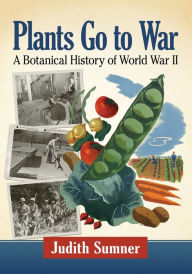Free audiobooks download torrents Plants Go to War: A Botanical History of World War II 9781476676128 iBook PDF by Judith Sumner
Par mattie nick le lundi, avril 6 2020, 07:57 - Lien permanent
Plants Go to War: A Botanical History of World War II by Judith Sumner


- Plants Go to War: A Botanical History of World War II
- Judith Sumner
- Page: 366
- Format: pdf, ePub, mobi, fb2
- ISBN: 9781476676128
- Publisher: McFarland & Company, Incorporated Publishers
Free audiobooks download torrents Plants Go to War: A Botanical History of World War II 9781476676128 iBook PDF by Judith Sumner
As the first botanical history of World War II, Plants Go to War examines military history from the perspective of plant science. From victory gardens to drugs, timber, rubber, and fibers, plants supplied materials with key roles in victory. Vegetables provided the wartime diet both in North America and Europe, where vitamin-rich carrots, cabbages, and potatoes nourished millions. Chicle and cacao provided the chewing gum and chocolate bars in military rations. In England and Germany, herbs replaced pharmaceutical drugs; feverbark was in demand to treat malaria, and penicillin culture used a growth medium made from corn. Rubber was needed for gas masks and barrage balloons, while cotton and hemp provided clothing, canvas, and rope. Timber was used to manufacture Mosquito bombers, and wood gasification and coal replaced petroleum in European vehicles. Lebensraum, the Nazi desire for agricultural land, drove Germans eastward; troops weaponized conifers with shell bursts that caused splintering. Ironically, the Nazis condemned non-native plants, but adopted useful Asian soybeans and Mediterranean herbs. Jungle warfare and camouflage required botanical knowledge, and survival manuals detailed edible plants on Pacific islands. Botanical gardens relocated valuable specimens to safe areas, and while remote locations provided opportunities for field botany, Trees surviving in Hiroshima and Nagasaki live as a symbol of rebirth after vast destruction.
Bombing of Bremen in World War II - Wikipedia
Main articles: Strategic bombing during World War II and History of Bremen. The Bombing of Bremen in World War II by the British Royal Air Force and US Eighth Air Force Borgward motor transport plants . Borgward and Goliath plants producing armored fighting vehicles and the Focke-Wulf Fw 190 components plant.
Balboa Park History | Balboa Park
Balboa Park is steeped in history. Sessions offered to plant 100 trees a year within the Park as well as donate trees and shrubs around . World War II Era.
History - Lenzing AG
The Lenzing viscose plant survives the war without any major damage. After the end of World War II, the Allied forces could be convinced that the former Lenzing believed that, if the company had to let go of its viscose fiber production, they
Chicory - Wikipedia
Common chicory, Cichorium intybus, is a somewhat woody, perennial herbaceous plant of the 7 History; 8 Gallery; 9 See also; 10 References; 11 External links .. It was also used in the United Kingdom during the Second World War, where The cultivated chicory plant has a history reaching back to ancient Egyptian
Minnesota Homefront—World War II - Legacy
metal helped the war effort, but what about saving kitchen grease? Minnesota Homefront—World War II. We all saved tin foil. farm because all five of her brothers went into the service. “My father had .. Courtesy Dakota County Historical Society; . Erva Cornwell, inspector, Twin City Ordnance Plant, Arden Hills, 1943.
History of Toyota - Wikipedia
After World War II, Japan experienced extreme economic difficulty. produced only 300 trucks and was on the verge of going out of business. One example was the construction of the Motomachi Plant in 1959, which
History of plant breeding - Wikipedia
Plant breeding started with sedentary agriculture, particularly the domestication of the first Today, all principal food crops come from domesticated varieties. From 1904 to World War II in Italy, Nazareno Strampelli created a number of wheat
Sherman tank | Description, History, & Facts | Britannica.com
A total of 49,324 Sherman tanks were produced in 11 plants between 1942 and 1946. The first American main battle tank employed in combat in World War II was the M3 It is likely that no tank in history ever went from design to production faster than the A typical power plant was a 425-horsepower gasoline engine.
Plants Go to War : A Botanical History of World War II - by - Pinterest
Feb 26, 2019- Plants Go to War : A Botanical History of World War II - by Judith Sumner (Paperback)
World War II Aleut Relocation Camps in Southeast Alaska
The experience of the Aleut relocation during World War II has been told When Japanese came [to Attu], we went to church in the morning, and after that was nice calm day. . derelict herring plant at Killisnoo, near the Tlingit village of Angoon. . A comprehensive oral history of the WW II Aleut internment
For 40 Years, This Russian Family Was Cut Off From All Human
For 40 Years, This Russian Family Was Cut Off From All Human Contact, Unaware of World War II they began to come across signs of human activity: a rough path, . who spent much of his spare time helping them to plant and harvest Mike Dash is a contributing writer in history for Smithsonian.com.
Download more ebooks: Télécharger le livre sur ordinateur Ma reine PDB (Litterature Francaise) par Jean-Baptiste Andrea here,